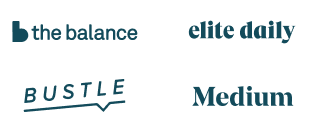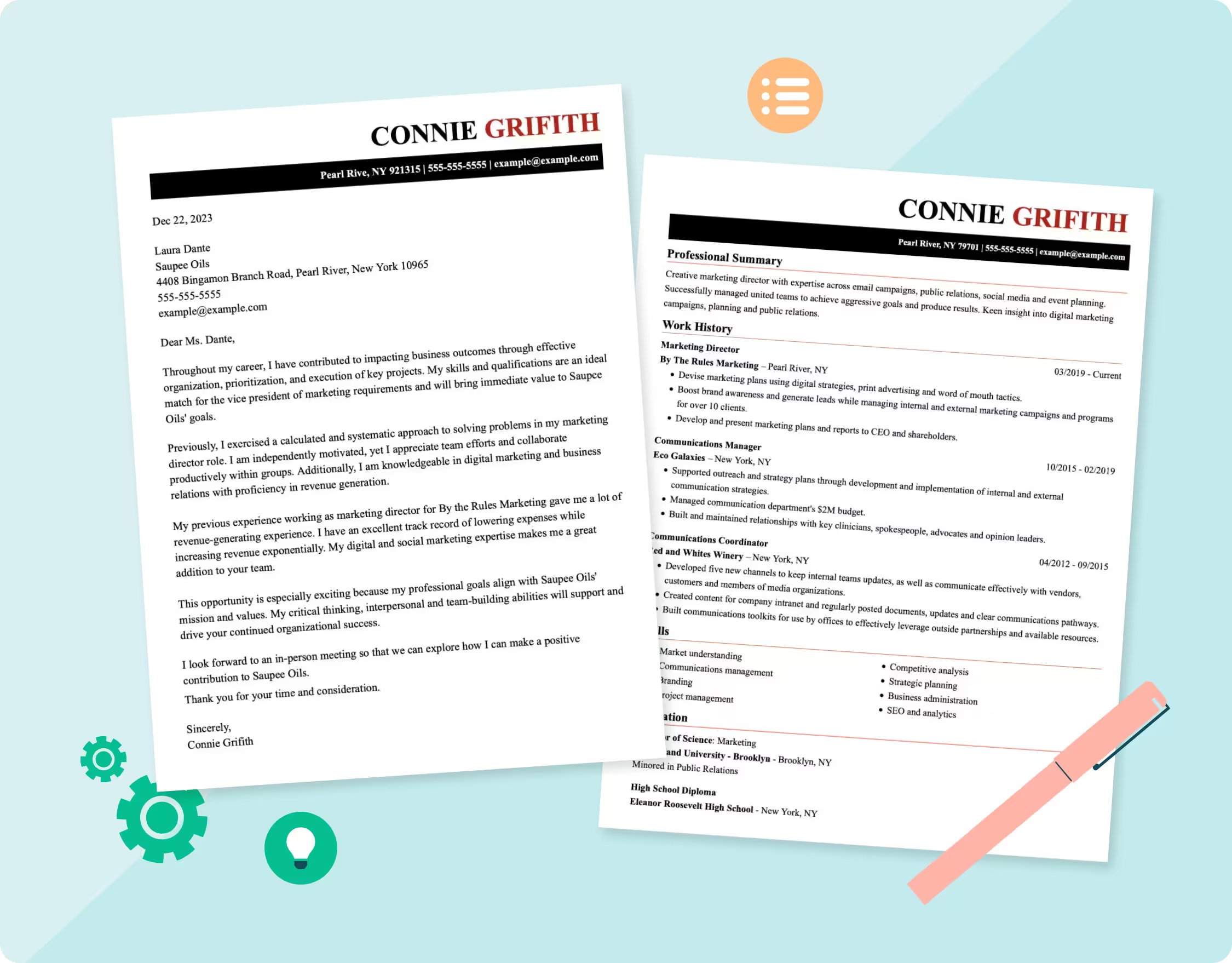- Featured in:


A compelling cover letter helps you shape and expand on your resume while providing the hiring manager insight into your personality and work ethic. It’s key to setting you apart from other candidates!
In this guide, you’ll learn how to write a cover letter for a job application and find writing tips and examples to help you make a lasting impression that gets you a callback.
1
What is a Cover Letter?
A cover letter is a formal business letter that builds on and augments your resume. It’s an excellent opportunity to expand on the information in your resume and pique the interest of a potential employer!
This three to four-paragraph document should highlight specific skills and accomplishments that make you an ideal candidate but, most importantly, showcase what you can offer to the company and how their work aligns with your career goals.
3
How to Write a Professional Cover Letter
After you’ve gathered all the information needed to create a strong cover letter, it’s time to start writing. The following sections provide a step-by-step guide.
Choose the right template
For a professional look, your cover letter should match your resume. A well-formatted, visually pleasing template can make a lasting impression. Check out how this job seeker maintained a consistent look throughout his job application:
Explore our library of free cover letter templates.
Write your header
A cover letter header usually includes your name, mailing address and the recipient’s contact information. However, you’re probably submitting your cover letter and resume via email or an online application portal — this modern method of application forgoes your typical mailing address in favor of your full name, phone number, professional email address and current city and state.
As for the recipient’s contact information, you’ll want to include the hiring manager’s full name, job title, company name and work address. This requires a little extra research. Here are two ways to find this information:
- Scan the job posting: Carefully review the job description. Not only will the posting include resume keywords that highlight the most desired skills for the job, but it may also include the hiring manager’s name and contact information.
- Search the company directory or LinkedIn: If the job advertisement doesn’t feature the name of the hiring point person, you’ll need to do a little research. Find out which department or office the open job is based in and use that information to identify the head of that department.
Here’s how it should look:
Alex Cohen
(555) 367-8967
alexcohen@email.com
San Francisco, CA
Nov. 7, 2023
Priya Walker
Director of Marketing
Wales Advertising
123 Orchard Drive
San Francisco, CA
Address your cover letter
Once you have the recipient’s full name, address your cover letter using the formal “Dear [recipient’s full name].” Some examples of appropriate cover letter greetings include:
- Dear [Job Title]’s Hiring Manager,
- Dear Head of [Job Title’s Department],
- Dear [Department] Recruiter,
- Dear [Recruiter’s Name],
- Dear Hiring Manager,
- Greetings,
Avoid outdated greetings like “To Whom It May Concern” and “Dear Sir or Madam.”
Write a strong introduction
Think of your opening as a personal mission statement. It must capture the recruiter’s attention to entice them to read the rest of your cover letter. Your introduction should include the following information:
- Who you are as a professional.
- What specific job title you’re applying for.
- Why you want to join the company.
- How your skills and work experience make you a good fit.
- Where you learned about the position.
Check out these sample introductions:
“Your advertisement in the Eureka Times-Standard for a building maintenance manager position at the Harborside Apartment Complex caught my eye as a perfect fit for my skills. I’m an experienced carpenter specializing in plumbing and electrical maintenance and repair. I can be on hand to address residents’ maintenance and upkeep requests.”
This job seeker quickly mentions where they saw the advertisement, what position they’re applying to, and which skills they possess that would make them an effective building manager.
“As a professional with excellent lesson planning and curriculum adoption skills, I was happy to see and apply for the experienced language arts teacher at Marshall School District post via the HiredBoard website. Your school’s charter statement aligns with my beliefs about how students can succeed, reassuring me that I would be well-placed among your staff and students.”
This educational job seeker quickly advertises their classroom leadership skills and alignment with the school’s mission statement, indicating they’d be a good culture fit and an asset to the school.
Tailor the body of your cover letter
In the body of your cover letter, emphasize your experience using practical examples of your career accomplishments concisely. Follow these steps to write a compelling cover letter body:
Step 1: Respond to the needs of the job.
You should already have a list of relevant skills and accomplishments that meet the job requirements. Now, describe these qualifications and achievements in detail to showcase you’re the ideal candidate for the role.
Check out these examples:
“As a store merchandising manager, I excelled in attention to detail. Every inventory we performed was on point to the fiscal dollar. This also carried through to every store element, from how employees dressed to the frequency with which we adjusted displays and the courtesy shown to customers. It’s the details where people find value, and it serves as my guiding philosophy as a manager and the kind of comprehensive work I hope to bring to Grayson’s Boutique.”
This retail job seeker understands the importance of meeting quarterly budgets to maintain a profitable inventory and a well-staffed store. They highlight their fiscal responsibility, budgeting experience, staff training, store-dressing and customer-first experience to highlight their qualifications as a site manager.
“My tenure as the head accountant at Brigtsen’s Lighting led to a multistep process that increased company revenue over two years by 34%. My initial analysis uncovered that our most considerable losses came from inefficient shipping practices. However, once we found more cost-effective logistics solutions, I spearheaded an audit of every element of our products and operations. From there, we minimized losses by working cross-functionally with production managers to source cheaper packaging materials. We maintained a high-quality product through these creative solutions while increasing efficiency and reducing costs.”
This job seeker highlights their business acumen and collaborative skills by showing how they identified vital profit-loss practices, worked with various departments to find alternate vendors, and implemented a streamlined onsite process to reduce shipping costs and increase company profits.
Step 2: Use the STAR method.
The Situation, Task, Action and Result or STAR interview method is a great way to present yourself as a proactive problem-solver and highlight additional achievements. See how this works in a cover letter:
“While working as marketing manager for Browne Agency, a client approached us with a unique problem: their wristwatch brand had zero brand awareness in the U.S. (SITUATION). I led several brainstorming sessions (TASK) with our creative team and implemented our strategy through connections in the talent industry (ACTION), managing to feature the product with top social media influencers. The result: Not only did it boost brand recognition, but also sales in the U.S. market increased by 22% (RESULT).”
Step 3: Format your cover letter strategically.
It’s important to keep the body of your cover letter short and direct to retain a hiring manager’s attention. Mindful design choices help you highlight your skills and qualifications. Some formatting tricks include:
Bulleted/numbered lists: The formulaic structure matches your resume and makes it easy for readers to scan your document and find vital information quickly.
Here's an example of how to write a cover letter with a numbered list:
“Working as an administrative assistant for two genetic testing clinics has honed my skills in the following areas:
- Professional phone manner, customer service and oral communication.
- Fluency in Office Suite, Google Workspace, Slack, Asana, Jira and Trello programs.
- Office hardware knowledge and problem-solving.
- Multitasking patient processing duties with phone reception, data entry and office management.
- Typing speed of 75 wpm.
- Great sense of teamwork and boosting office morale.”
Use bullet or numbered entries sparingly — an overreliance on them can strip away your voice. An effective cover letter highlights your skills and gives hiring managers insight into your thoughts and personality.
You can counteract this by combining complete sentences backed with skills-based bullet or numbered entries like the following job seeker. They cover their collaborative work style before listing their technical skills:
“Overall, as a web developer, I spent over two years at McClusky Developers working to perfect my base skills. Furthering my professional education by working for Beastcorp, I began asserting myself as a leader and more of a presence in our group meetings. I’ve earned a reputation as an expert in the following areas:
- C++ and Java fluency.
- Debugging pages without a given error code structure.
- Increasing performance and stability through troubleshooting.”
End with a call to action
Your final paragraph should reassure the hiring manager of your interest in the open job. Additionally, it must include an invitation to reconnect in an interview. Use this opportunity to add your availability and your contact information.
Here's an example:
“Thank you for reviewing my application. I attached my design portfolio and resume so you can see my work samples. Feel free to contact me via xxx-xxx-xxxx or email this Wednesday and Thursday during normal business hours — I look forward to meeting and discussing this design opportunity further.”
Sign off
Conclude your cover letter with a formal farewell and typed signature. Appropriate sign-offs could include:
- Thank you for your time,
- Thank you,
- Best,
- Kind regards,
5
5 Tips on How to Write a Good Cover Letter
The step-by-step guide above will make writing a cover letter quick and easy. Consider these writing tips to take your cover letter to the next level.
How to Write a Cover Letter FAQ
How to write a cover letter with no experience?
Even if you never had a formal job, you have job-relevant experience thanks to school, family commitments or community service. If you took college courses, you already know how to keep to a schedule and complete tasks within a specified period — so let’s discuss how we translate that experience into job-related skills.
To write an effective cover letter without formal job experience, focus on transferable skills like:
- Teamwork includes group projects with high grades or after-school sports with favorable win rates.
- Time management is related to juggling multiple classes or after-school activities.
- Customer service related to volunteering for bake sales and fundraising.
- Basic math skills such as math courses or cashing handling experience.
- Physical stamina related to P.E. or after-school sports.
- Tutoring skills related to your academic courses and volunteering.
How to write a cover letter without a name?
Tailoring your cover letter is essential to making an impression. We always recommend taking the time to research the recipient’s name. However, if after hours of research, you still can’t find their name, the appropriate way to address your cover letter is using the following:
- Dear Hiring Manager,
- Dear Head of [Department],
- Dear [Department] Recruiter,
How can you make your cover letter stand out?
Review the job description carefully and look for “resume keywords.” You can find these keywords by looking for repeated phrases or highlighted responsibilities throughout the job advertisement.
These words or phrases are used by applicant tracking systems (ATS) and hiring managers to rate applicants — strategically placing them throughout your cover letter reassures hiring managers that you carefully read the descriptions and thoughtfully consider what qualifications you feature.
What are the three main things needed in a cover letter?
A cover letter must make a lasting impression, market yourself as the ideal candidate and encourage the reader to follow up. Here’s what you need to include to achieve this:
- Attention-grabbing and dynamic introduction.
- A direct and concise body that details the candidate’s qualifications.
- An invitation to continue the conversation over an interview with the candidate’s contact information and availability.
How to write a cover letter for an internship?
To write an effective internship cover letter, provide transferable skills based on your academic training or previous experience.
For example, this second-year business student advertises their data analysis and business strategy knowledge to conceptualize a potential marketing campaign their employer might use. This strategy demonstrates how this intern applicant is already applying their education training to benefit their potential employer.
“As a business management student, I am excited to apply for New Wave’s summer internship program. I look forward to applying my data analysis knowledge and developing a business strategy based on the exciting developments you and your current product team are creating. I look forward to working with your team and my fellow summer associates to draft an aggressive product marketing campaign you can adopt soon.”





